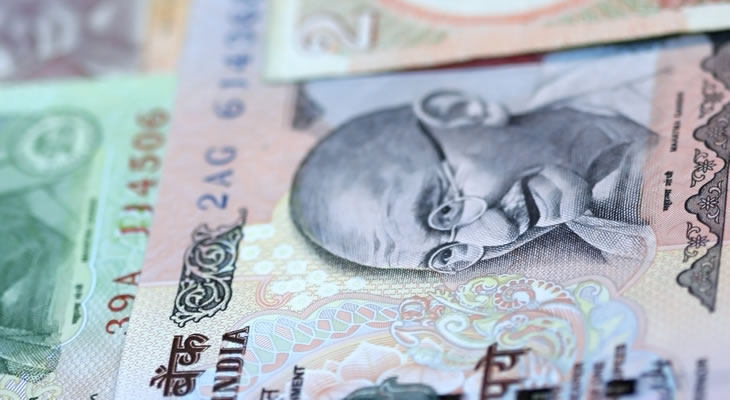- Markets encouraged after RBI left interest rates unchanged – Rupee bolstered by lack of policy easing
- Bullish UK industrial output data rallied GBP/INR exchange rate – Domestic economy showed fresh signs of strength
- Weaker Chinese trade figures failed to soften Rupee – Risk appetite defied slowdown concerns
- GBP/INR exchange rate forecast to climb on UK trade balance – Narrowed deficit to encourage Pound optimism
Poor UK House Prices Extended GBP/INR Exchange Rate Downtrend
Demand for the Pound (GBP) weakened on Thursday morning in response to a disappointing RICS House Price Balance report, with the headline figure having dipped from 39% to just 19% in May. Raising concerns about the strength of the domestic housing market, this prompted the Pound Sterling to Indian Rupee (GBP/INR) exchange rate to trend lower around 96.4330.
(Previously updated at 15:01 on 08/06/2016)
Indian Rupee (INR) Strengthened after RBI Held Interest Rates
Trade has been fairly volatile for the Pound Sterling to Indian Rupee (GBP/INR) exchange rate since the start of the week. While sentiment towards the Pound had been severely dampened by a round of ‘Brexit’-supportive opinion polls, this did not ultimately hamper the currency pair for long. An apparently erroneous trade during Tuesday’s Asian session prompted a sharp spike in the value of Sterling, which subsequently set the GBP/INR exchange rate on a fresh uptrend.
Investors also took encouragement from a stronger-than-expected BRC Like-For-Like Sales figure, which indicated that consumer demand had strengthened 0.5% on the year in May. This somewhat eased worries that referendum uncertainty has been negatively weighing on the UK economy, offering the Pound an extra boost against rivals on Tuesday.
The reduced odds of a summer interest rate hike from the Federal Reserve helped to improve the appeal of the Indian Rupee (INR), meanwhile, as the bearishness of the US Dollar (USD) eased pressure on the emerging-market currency. Confidence in the Rupee was boosted further by the Reserve Bank of India’s (RBI) decision to leave interest rates unchanged at its latest policy meeting. As researchers at BBH noted:
‘The RBI said that its inflation forecasts were retained, but with an “upside bias.” Until the inflation outlook is clearer, the RBI is likely to remain on hold. The central bank next meets August 9.’
This prompted investors to increasingly buy into the Rupee, pushing the GBP/INR exchange rate away from its weekly high of 97.5539 as positive sentiment towards the Pound eased.
Improved UK Production Data Shored up GBP/INR Exchange Rate
Confidence in higher-yielding assets weakened once again on Wednesday morning, however, after the latest raft of Chinese trade data prompted market jitters. Investors were discouraged to find that exports had contracted by -4.1% on the year in May, reigniting worries that the world’s second largest economy is facing a significant slowdown. While this fresh weakness could spill over into the neighbouring Indian economy, though, the impact on the Rupee was somewhat limited.
Demand for the Pound was boosted by the news that Industrial and Manufacturing Production figures had strongly bettered expectations in April. This took investors somewhat by surprise in the wake of previous signs of weakness within the manufacturing sector, suggesting that the economy was not in as poor a state as feared. The details of the data were generally encouraging, as the BBH research team noted:
‘UK industrial output jumped 2.0%, the biggest increase in four years. Manufacturing production itself rose 2.3%. Pharmaceutical output surged 8.6%, and auto production (ostensibly for domestic demand) rose. There was a 3.9% rise in gas and electricity production, though oil and gas extraction fell 1.3%.’
However, the market reaction to this stronger showing was muted due to the continued investor preoccupation with referendum developments. With the vote just over two weeks away the possibility of a ‘Brexit’ remains a significant deterrent for traders, preventing the Pound from entering a bullish run against rivals.
GBP/INR Exchange Rate Forecast: Narrowed UK Trade Deficit Could Boost Pound Higher
Further support for the Pound could materialise on Thursday if the UK’s Visible Trade Balance figure indicates a narrowing of the trade deficit. A smaller deficit may encourage investors to continue buying into Sterling, furthering optimism that ‘Brexit’-based uncertainty has not overly damaged the outlook of the domestic economy. If there are any signs that the ‘Leave’ campaign is building further steam, however, the impact of any positive data on the GBP/INR exchange rate is likely to be severely limited.
Friday’s Indian Industrial and Manufacturing Production data is expected to offer encouragement to the Rupee, meanwhile. Forecasts suggest that output levels improved on the year in April, with industrial production anticipated to have edged higher from 0.1% to 0.3%. This would encourage hopes for a stronger second quarter GDP and help to cement India’s place as the world’s fastest growing economy. As a result the GBP/INR exchange rate would likely cede its recent gains.
Current GBP, INR Exchange Rates
At the time of writing, the Pound Sterling to Indian Rupee (GBP/INR) exchange rate was trending higher around 96.9910, while the Indian Rupee to Pound Sterling (INR/GBP) pairing was moving lower in the region of 0.0103.


Comments are closed.